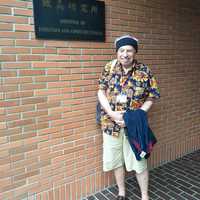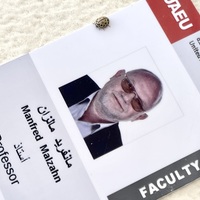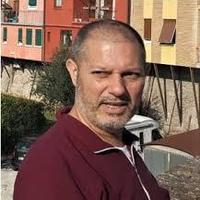
Binghan Zheng
Supervisors: jin huang, di xiao, and yifang wang
Phone: 00441913343451
Address: School of Modern Languages & Cultures, Durham University
Elvet Riverside, New Elvet, Durham DH1 3JT, UK
Phone: 00441913343451
Address: School of Modern Languages & Cultures, Durham University
Elvet Riverside, New Elvet, Durham DH1 3JT, UK
less
Related Authors
Lucja Biel
University of Warsaw
Mine Yazıcı
Istanbul University
David Seamon
Kansas State University
John Sutton
Macquarie University
Didier COSTE
Université Bordeaux-Montaigne
Rob S E A N Wilson
University of California, Santa Cruz
Manfred Malzahn
United Arab Emirates University
Ricardo Muñoz Martín
Università di Bologna
Sharon O'Brien
Dublin City University
André Bueno
UERJ - Universidade do Estado do Rio de Janeiro / Rio de Janeiro State University
InterestsView All (9)










Uploads
Papers by Binghan Zheng
as a contentious one (Fawcett 1997), with reciprocal links often disregarded
in favour of the sovereign status of each field. This entry aims to synthesise how
linguistic reflection, in the sense of theoretical reflection on language from antiquity
to the present, triggered conceptualisations of translation as an act of interpretative
transfer between two languages. It will start with ideas from general linguistics to
continue with the interdisciplinary approaches in textlinguistic, sociolinguistic,
psycholinguistic and neurolinguistic translation studies (TS).
■Translating cultures and modernity
■Translation and World Literature
■Translation, education and society
■New media, mediation and translation
■Regional interdisciplinary translation studies
■Corpus-based translation studies
■Process-oriented studies in translation and interpretation
■Pedagogical Translation and Interpretation
I. Is TIS mature enough as a discipline to undertake comparative studies? And also: Can TIS become mature enough without undertaking comparative studies?
II. Is the insularity of translation/interpreting research—whether geographical or temporal—epistemologically problematic? Are comparative studies feasible/promising?
III. What can the relationship between regional/case studies and more generalizing, comparative studies be? To what extent is W. H. Goodenough’s insistence on keeping ethnography and comparative sociology apart because an ethnographer is constructing a theory that will make intelligible what goes on in a particular social universe, while a comparatist is trying to find principles common to many different universes, mutatis mutandis, applicable to translation/interpreting studies?
IV. Can chronotopically-specific studies help researchers fathom the generalizability of identified translational phenomena? Based on a comparison of time- and space-specific findings, can a typology of translation/interpreting be developed? What axes of the quest for types can be proposed or explored: different types of translation/interpreting praxis? different types of translation/interpreting descriptions and/or prescriptions, social and cultural representations, histories and historiographies, theories and conceptualizations of translation/interpreting? the roles assumed by or ascribed to translation/interpreting?
V. What might the methodological and conceptual ‘nitty-gritty’ of CTIS look like?
Books by Binghan Zheng
The argument put forth is that translating is a choice-making process, based on the optimization skills, adaptability and experience of the translator, and that this choice-making process is indicative of the translator’s proficiency. A triangulation pattern is proposed as the main method for studying the translation process, combining concurrent TAPs, target text evaluation, questionnaires and interviews, observation notes, and translation revision records.
There are 18 subjects in this study, divided into three groups according to their backgrounds in translation and provided with prior training in TAPs experimentation. Each subject is required to carry out two think-aloud translating tasks, whilst being tape-recorded, and then is asked to complete a questionnaire and undergo an interview. Afterwards, all translation versions are marked and rated anonymously by two experts in translation.
The crux of the study lies in examining how the subjects carry through choice-making on the translation units, the process of decision-making, and the application of translation instruments. The major findings are as follows:
Firstly, generally professionals perform a so-called “macro-control” strategy in most choice-making behaviours. Compared with non-professionals, they select larger language units both as subjective translation units and as objective translation units, pay more consideration to global problems and refer more to the macro-context when facing problems. The above characteristics of professionals are in accordance with their performances in applying translation instruments. They are ‘high-risk-takers’ and seldom seek help from dictionaries. The results indicate that the professional’s cognitive mode is likely to be “top-down” when translating, which means they take the meaning of the whole text as the first priority, and then systematically focus on details.
Secondly, the semi-professional’s behaviour resembles that of the professional in the way they consider the translation brief and refer to the expected translation structure, translation theories and principles. Yet, they are more similar to novices in respect of the translation units they apply, the types of translation problems they consider and the types of context they refer to. It thus can be concluded that for translation trainees, theory is easy to assimilate, while the practical competences are more difficult to develop over a short period. Translation trainees should make greater efforts to practise doing translation in order to gain sufficient experience and knowledge of the translation process.
Based on a comparison of typical samples from the three types of subjects, this study proposes optimal strategies for the four levels of meaning, structure, function and monitoring of the results. It then verifies them through quantitative data based on all samples. A translator first of all faces a sequence of translation problems and makes decisions on the above four levels, and then resolves the problems and generates a translation by using various strategies. The study indicates that a translator uses translation theories or principles as guidance, consciously or unconsciously, during choice-making or decision-making. And furthermore, the “minimax principle” is virtually always the underlying foundation and reference point for a translator during his/her choice-making in translating.
as a contentious one (Fawcett 1997), with reciprocal links often disregarded
in favour of the sovereign status of each field. This entry aims to synthesise how
linguistic reflection, in the sense of theoretical reflection on language from antiquity
to the present, triggered conceptualisations of translation as an act of interpretative
transfer between two languages. It will start with ideas from general linguistics to
continue with the interdisciplinary approaches in textlinguistic, sociolinguistic,
psycholinguistic and neurolinguistic translation studies (TS).
■Translating cultures and modernity
■Translation and World Literature
■Translation, education and society
■New media, mediation and translation
■Regional interdisciplinary translation studies
■Corpus-based translation studies
■Process-oriented studies in translation and interpretation
■Pedagogical Translation and Interpretation
I. Is TIS mature enough as a discipline to undertake comparative studies? And also: Can TIS become mature enough without undertaking comparative studies?
II. Is the insularity of translation/interpreting research—whether geographical or temporal—epistemologically problematic? Are comparative studies feasible/promising?
III. What can the relationship between regional/case studies and more generalizing, comparative studies be? To what extent is W. H. Goodenough’s insistence on keeping ethnography and comparative sociology apart because an ethnographer is constructing a theory that will make intelligible what goes on in a particular social universe, while a comparatist is trying to find principles common to many different universes, mutatis mutandis, applicable to translation/interpreting studies?
IV. Can chronotopically-specific studies help researchers fathom the generalizability of identified translational phenomena? Based on a comparison of time- and space-specific findings, can a typology of translation/interpreting be developed? What axes of the quest for types can be proposed or explored: different types of translation/interpreting praxis? different types of translation/interpreting descriptions and/or prescriptions, social and cultural representations, histories and historiographies, theories and conceptualizations of translation/interpreting? the roles assumed by or ascribed to translation/interpreting?
V. What might the methodological and conceptual ‘nitty-gritty’ of CTIS look like?
The argument put forth is that translating is a choice-making process, based on the optimization skills, adaptability and experience of the translator, and that this choice-making process is indicative of the translator’s proficiency. A triangulation pattern is proposed as the main method for studying the translation process, combining concurrent TAPs, target text evaluation, questionnaires and interviews, observation notes, and translation revision records.
There are 18 subjects in this study, divided into three groups according to their backgrounds in translation and provided with prior training in TAPs experimentation. Each subject is required to carry out two think-aloud translating tasks, whilst being tape-recorded, and then is asked to complete a questionnaire and undergo an interview. Afterwards, all translation versions are marked and rated anonymously by two experts in translation.
The crux of the study lies in examining how the subjects carry through choice-making on the translation units, the process of decision-making, and the application of translation instruments. The major findings are as follows:
Firstly, generally professionals perform a so-called “macro-control” strategy in most choice-making behaviours. Compared with non-professionals, they select larger language units both as subjective translation units and as objective translation units, pay more consideration to global problems and refer more to the macro-context when facing problems. The above characteristics of professionals are in accordance with their performances in applying translation instruments. They are ‘high-risk-takers’ and seldom seek help from dictionaries. The results indicate that the professional’s cognitive mode is likely to be “top-down” when translating, which means they take the meaning of the whole text as the first priority, and then systematically focus on details.
Secondly, the semi-professional’s behaviour resembles that of the professional in the way they consider the translation brief and refer to the expected translation structure, translation theories and principles. Yet, they are more similar to novices in respect of the translation units they apply, the types of translation problems they consider and the types of context they refer to. It thus can be concluded that for translation trainees, theory is easy to assimilate, while the practical competences are more difficult to develop over a short period. Translation trainees should make greater efforts to practise doing translation in order to gain sufficient experience and knowledge of the translation process.
Based on a comparison of typical samples from the three types of subjects, this study proposes optimal strategies for the four levels of meaning, structure, function and monitoring of the results. It then verifies them through quantitative data based on all samples. A translator first of all faces a sequence of translation problems and makes decisions on the above four levels, and then resolves the problems and generates a translation by using various strategies. The study indicates that a translator uses translation theories or principles as guidance, consciously or unconsciously, during choice-making or decision-making. And furthermore, the “minimax principle” is virtually always the underlying foundation and reference point for a translator during his/her choice-making in translating.